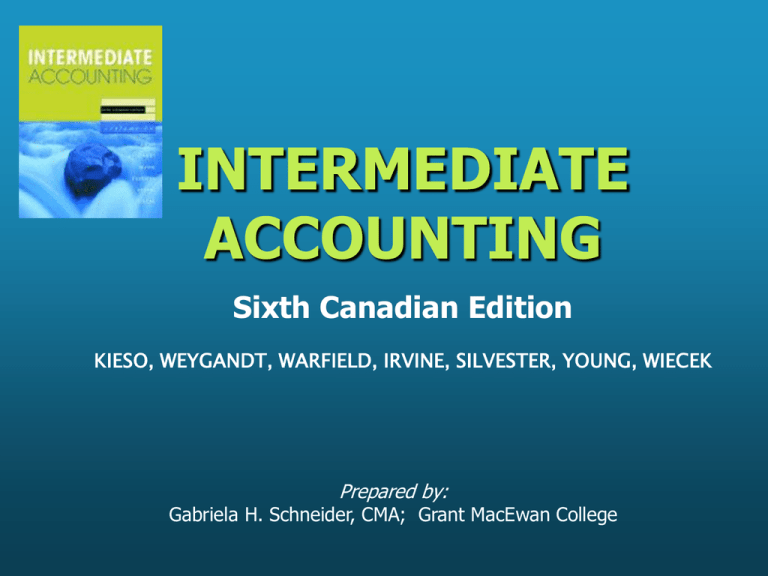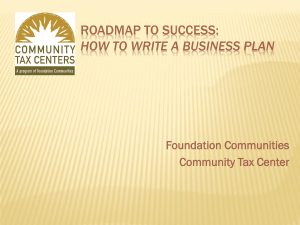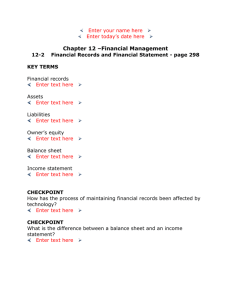
INTERMEDIATE
ACCOUNTING
Sixth Canadian Edition
KIESO, WEYGANDT, WARFIELD, IRVINE, SILVESTER, YOUNG, WIECEK
Prepared by:
Gabriela H. Schneider, CMA; Grant MacEwan College
CHAPTER
5
Financial Position and Cash Flows
Learning Objectives
1. Identify the uses and limitations of a balance
sheet.
2. Identify the major classifications of the
balance sheet.
3. Prepare a classified balance sheet.
4. Identify balance sheet information requiring
supplemental disclosure.
Learning Objectives
5. Identify major disclosure techniques for the
balance sheet.
6. Indicate the purpose of the statement of cash
flows.
7. Identify the content of the statement of cash
flows.
8. Prepare a statement of cash flows.
9. Understand the usefulness of the statement of
cash flows.
Balance Sheet and Statement
of Cash Flows
Balance Sheet
Usefulness
Statement of
Cash Flows
Limitations
Purpose
Classification
Content and
Format
Format
Additional
information
Techniques of
disclosure
Terminology
Preparation
Usefulness
Balance Sheet: Usefulness
• The balance sheet provides information:
– for evaluating the capital structure
– for computing rates of return
• It is also useful for analysing an enterprise’s:
– liquidity (ability to pay current and maturing debt)
– solvency (ability to pay debt, and interest, as it
matures)
– financial flexibility (ability to respond to unexpected
needs and opportunities)
Balance Sheet: Limitations
1
Most assets and liabilities are stated at historical
cost.
–
–
2
Judgements and estimates are used in
determining many of the items reported.
–
3
information presented is reliable, however
reporting at current fair value may result in more
relevant information
“soft” numbers (estimates) less reliable than “hard”
numbers
The balance sheet does not report items that can
not be objectively determined (e.g. The ‘value’ of
experienced staff).
Balance Sheet Classification
• Similar items are grouped together, with sub-total
• Individual balance sheet items should be
• reported separately, and in
• sufficient detail in order to
– allow users to assess amounts, timing and
uncertainty of future cash flows
– allow users to evaluate: liquidity
financial flexibility
profitability
risk
Balance Sheet Classification
•
Guidelines for reporting items separately:
1) Assets that differ in their type or expected
function in the central operations
2) Assets and liabilities that have different
implications for the enterprise’s financial
flexibility
3) Assets and liabilities with different general
liquidity characteristics
Balance Sheet: Classification
Assets
• Current Assets
• Long-term
investments
• Property, plant, and
equipment
• Intangible assets
• Other assets
Liabilities and Equity
• Current liabilities
• Long-term debt
• Owners’ equity
– Capital stock
– Additional paid-in
capital
– Retained earnings
Current Assets
• Current assets are expected to be consumed, sold,
or converted into cash:
– either in one year or
– in the normal operating cycle, whichever is longer.
• They are presented in order of liquidity
• The following valuation principles are used:
– short-term investments at fair value
– accounts receivable at net realizable value
The Business Operating Cycle
for Manufacturing
Purchase
Raw Materials
Manufacture
Product
Cash
Sell Product
to Customers
Current Assets
• Five major items comprise Current
Assets
-
Cash
Short-term investments
Receivables
Inventories
Prepayments (Prepaid Expenses)
Current Assets - Cash
• Includes cash and cash equivalents
• Defined as:
– cash
– demand deposits
– short-term, liquid investments readily convertible
to a known cash amount, and not subject to
material value changes
• Any known restrictions to cash must be
disclosed
Current Assets - Receivables
• Amounts should be reported separately based
on the nature of their origin:
– ordinary trade accounts
– amounts owing by related parties
– other (material) unusual items
• Separate disclosure required for:
– anticipated losses (uncollectibles)
– amount and nature of non-trade receivables
– receivables pledged as collateral
Current Assets - Inventories
• Valuation basis (lower of cost or market)
disclosed
• Method of pricing (FIFO or LIFO) disclosed
• Manufacturing enterprise will disclose
completion stage of inventories
– raw materials
– work in progress
– finished goods
Current Assets – Prepaid
Expenses
• Defined as: expenditures already made for
benefits to be received within one year or
within the operating cycle
• Most common examples include
–
–
–
–
insurance
rent
advertising
supplies
• Current practice is to report some prepaid
amounts where the benefit extends beyond
one year (or operating cycle)
Long-Term Investments
• Four common types of Long-Term Investments:
– investments in securities
– investments in tangible fixed assets not used in current operations
– investments set aside in special funds for specific purposes
– investments in non-consolidated subsidiaries or affiliated
companies
• The intent of these investments is that they are:
- held for an extended period of time
- reported at cost or amortized cost
- only adjusted to current value if there is a nontemporary decline in value
Property, Plant and Equipment
• Physical (tangible) assets used in the
regular operations of the business to
generate revenue
• Disclosure requirements include:
– basis of valuation
– nature of any liens held against the asset
– accumulated amortization
Intangible Assets
• Those assets without physical substance, held to
generate revenue
• High degree of uncertainty regarding future benefits
• Subject to arbitrary write-downs or write-offs due to
valuation/measurement difficulties
• Include (most common):
–
–
–
–
–
Patents
Copyrights
Franchises
Goodwill
Trademarks, and trade names
Current Liabilities
• Current liabilities are liquidated:
– either through the use of current assets, or
– by creation of other current liabilities
• Examples of current liabilities include:
– payables resulting from acquisitions of goods and
services
– collections received in advance of services
– other liabilities which will be paid in the short term
Working Capital
Current Assets - Current Liabilities = Working Capital
• A key indicator of the company’s shortterm liquidity
• Not usually disclosed on the balance
sheet
• Often calculated by creditors
Long-term Liabilities
• Long-term obligations are those not expected to
be paid within the operating cycle
• Examples are:
– obligations arising from specific financing
situations
– obligations arising from ordinary business
operations
– obligations that are contingent
– Balance sheet presentation requires reporting
that portion due within the next year as a current
liability
Owners’ Equity
• Capital Shares:
– Number of authorized and issued shares
– Outstanding amounts
• Contributed Surplus:
– Usually reported as one amount
• Retained Earnings:
– Divided between un-appropriated and restricted
amounts
– Reacquired (Treasury) shares reported as a
reduction of equity
Balance Sheet: Additional
Information Reported
•
Additional information may be:
-
•
information not presented elsewhere, or
information that qualifies items in the balance
sheet
Five main types of additional information:
1.
2.
3.
4.
5.
Contingencies
Accounting policies
Contractual situations
Additional detail
Subsequent events
Balance Sheet: Techniques of
Disclosure
1 Parenthetical explanations (following the
items in the balance sheet)
2 Notes (to the balance sheet)
3 Cross references and contra items (where
assets and liabilities may be cross-referenced)
4 Supporting schedules (as for fixed assets
depreciation)
Statement of Cash Flows
• Assesses the firm’s ability to generate
cash and cash equivalents
• Assesses the firm’s cash requirements
or uses
• Statement of Cash Flows shows
– Where did the cash come from?
– What was the cash used for?
– What was the change in the cash balance?
Statement of Cash Flows
• Cash activities are divided into three main
categories:
Operating Activities
– Normal day-to-day activities
Investing Activities
– Changes in long-term assets and investments
Financing Activities
– Changes in equity and non-operating liabilities
Statement of Cash Flows
• There are TWO methods of preparing the
statement of cash flows:
– direct method (alternative #1)
– indirect method (alternative #2)
• The direct method analyses balance sheet
account changes
• The indirect method analyses the changes in cash
by determining cash flows directly for each source
or use of cash
• Any non-cash transactions are omitted from the
statement (under each method)
Cash Inflows and Outflows
Operating
Activities
When operating cash
receipts > cash
expenditures
Investing Activities
Sale of property, plant
and equipment
Sale of debt or equity
securities of other
entities
Collection of loans to
other entities
Cash Pool
Cash Inflows
Financing Activities
Issuance of equity
securities
Issuance of debt (bonds
and notes)
Cash Inflows and Outflows
Cash Outflows
Cash Pool
Operating
Activities
When operating cash
expenditures < cash
receipts
Investing Activities
Purchase of property,
plant and equipment
Purchase of debt or
equity securities of other
entities
Loans to other entities
Financing Activities
Payment of dividends
Redemption of debt
Reacquisition of capital
stock
Preparing a Cash Flow
Statement
Alternative #1 (Direct Method)
Information required:
1. Comparative Balance Sheets
2. Current Income Statement
3. Other information and transaction data
Direct Method
Operating Activities
• Start with Net Income (Loss)
• Changes in Current Assets (other than cash) and
Liabilities
– Increase in a current asset = use of funds (Decrease = source
of funds)
– Increase in a current liabilities = source of funds (Decrease =
use of funds)
• Non-cash expenses (e.g. amortization, bad debts
expense)
• Non-operating gains and losses
– Gains are treated as a use of funds from operating activities
– Losses are treated as a source of funds from operating
activities
Direct Method
Investing Activities
• Changes in Long-term assets
– Increase = use of funds
– Decrease = source of funds
• If assets have been disposed, report only the
cash proceeds of disposition
Financing Activities
• Changes in Long-term liabilities and equity
– Increase = source of funds
– Decrease = use of funds
Usefulness of the Statement
of Cash Flows
• Cash is the long-term indicator of a
firm’s success or failure
• Useful to creditors in answering three
main questions
1. Success in generating net cash from operating
activities
2. Operating cash flow trends or patterns
3. Major reasons for positive or negative net cash
from operating activities
Usefulness of the Statement
of Cash Flows
Provides insight within the following areas:
Financial Liquidity
Current Cash Debit Coverage Ratio =
Net Cash Provided by Operating Activities
Average Current Liabilities
Financial Flexibility
Cash Debt Coverage Ratio =
Net Cash Provided by Operating Activities
Average Total Liabilities
Usefulness of the Statement
of Cash Flows
Cash Flow Patterns
•
Is the firm getting the biggest “bang” for
its buck?
Free Cash Flow
•
•
Net cash from operations less capital
expenditures and dividends
Indicates discretionary cash flow (cash left
to invest or expand)
COPYRIGHT
Copyright © 2002 John Wiley & Sons Canada, Ltd.
All rights reserved. Reproduction or translation of
this work beyond that permitted by CANCOPY
(Canadian Reprography Collective) is unlawful.
Request for further information should be
addressed to the Permissions Department, John
Wiley & Sons Canada, Ltd. The purchaser may
make back-up copies for his / her own use only and
not for distribution or resale. The author and the
publisher assume no responsibility for errors,
omissions, or damages, caused by the use of these
programs or from the use of the information
contained herein.





